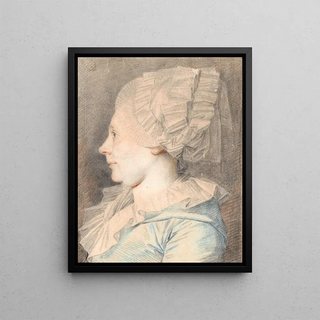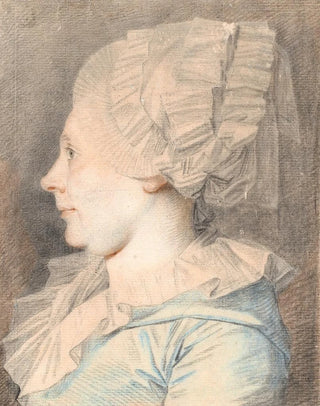Art print | Portrait of Anne Cathrine Maale née Basse, turned left - Jens Juel


View from behind

Frame (optional)
Portrait of Anne Cathrine Maale née Basse, profile turned to the left - Jens Juel – Captivating introduction
The "Portrait of Anne Cathrine Maale née Basse, profile turned to the left" by Jens Juel is an iconic work that embodies the very essence of neoclassical portraiture. Created at the end of the 18th century, this painting stands out for its finesse of execution and depth of expression. Anne Cathrine Maale, wife of a Danish notable, is depicted in a moment of silent contemplation, her gaze directed toward the horizon, as if she were about to reveal the secrets of her soul. The soft light bathing her face accentuates the delicacy of her features, while the neutral background allows the viewer to focus on the central figure. This work is not merely a simple portrait; it is a living testament to an era when art and society converged in a quest for beauty and truth.
Style and uniqueness of the work
Jens Juel's style is characterized by a remarkable mastery of color and light. In this portrait, he manages to capture not only Anne Cathrine Maale's physical appearance but also her spiritual essence. The subtle nuances of her complexion and the play of shadows on her face reveal an artistic sensitivity that transcends mere realistic rendering. Juel uses soft lines and delicate contours, creating an intimate atmosphere that invites the viewer to approach and contemplate. The slightly tilted pose of the head, combined with a thoughtful gaze, gives the work a profound psychological dimension. This portrait is thus much more than a representation; it becomes a mirror of human emotions, an exploration of thoughts and feelings that still resonate today.
The artist and his influence
Jens Juel, a central figure in 18th-century Danish art, knew how to leave his mark by blending tradition and innovation. Trained in Copenhagen workshops before honing his talent abroad, he managed to incorporate neoclassical influences while developing a personal style. His portraits, often imbued with great dignity, testify to his skill in capturing the personality of his subjects. J

Matte finish

View from behind

Frame (optional)
Portrait of Anne Cathrine Maale née Basse, profile turned to the left - Jens Juel – Captivating introduction
The "Portrait of Anne Cathrine Maale née Basse, profile turned to the left" by Jens Juel is an iconic work that embodies the very essence of neoclassical portraiture. Created at the end of the 18th century, this painting stands out for its finesse of execution and depth of expression. Anne Cathrine Maale, wife of a Danish notable, is depicted in a moment of silent contemplation, her gaze directed toward the horizon, as if she were about to reveal the secrets of her soul. The soft light bathing her face accentuates the delicacy of her features, while the neutral background allows the viewer to focus on the central figure. This work is not merely a simple portrait; it is a living testament to an era when art and society converged in a quest for beauty and truth.
Style and uniqueness of the work
Jens Juel's style is characterized by a remarkable mastery of color and light. In this portrait, he manages to capture not only Anne Cathrine Maale's physical appearance but also her spiritual essence. The subtle nuances of her complexion and the play of shadows on her face reveal an artistic sensitivity that transcends mere realistic rendering. Juel uses soft lines and delicate contours, creating an intimate atmosphere that invites the viewer to approach and contemplate. The slightly tilted pose of the head, combined with a thoughtful gaze, gives the work a profound psychological dimension. This portrait is thus much more than a representation; it becomes a mirror of human emotions, an exploration of thoughts and feelings that still resonate today.
The artist and his influence
Jens Juel, a central figure in 18th-century Danish art, knew how to leave his mark by blending tradition and innovation. Trained in Copenhagen workshops before honing his talent abroad, he managed to incorporate neoclassical influences while developing a personal style. His portraits, often imbued with great dignity, testify to his skill in capturing the personality of his subjects. J






